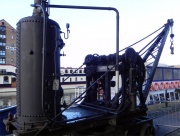Balmforth Brothers





Balmforth Brothers of Peel Ings Foundry, Rodley were manufacturers of steam cranes, hoists and types of lifting gear, and locomotives.
1820 Jeremiah Balmforth, David Smith and Jeremiah Booth went into business together.
1840 The output of the firm consisted mainly of hand operated guy and derrick cranes.
1841 Balmforth, Smith and Booth, millwrights of Calverley, Pudsey (near Rodley)[1]
1841 July. Mention of Balmforth, Smith and Booth erecting machinery at a mill at Newlay.[2]
1847 January. Jeremiah Booth sold his one-third interest in Balmforth, Smith and Co to his two partners[3] and started on his own account in adjacent works at Rodley - see Joseph Booth and Brothers.
1858 William Fras. and Jeremiah Balmforth were millwrights in Bramley near Leeds[4]
1866 William Balmforth, engineer, of Rodley[5]
1870 William Balmforth, brass founder, engineer and millwright, of Rodley[6]
1876 built at least three steam locomotives. [7]
c.1880 William Balmforth died
1881 The business was carried on by William's executors. Also living in Rodley were James Balmforth (Pell Ings Cottage) and Joseph C. Balmforth (Wesley Terrace)[8]
1888 Contractors' plant maker, business carried on by William Balmforth's executors[9]
1890s Built two locomotives for Eure Pits Limestone Quarry near Dalton-in-Furness (C W Hunter and Co). These were 0-4-0 locos with vertical-boilers. One later worked on the Vickerstown construction project at Barrow. One of these engines was photographed in 1903 at Crooklands. [10]
The company carried on until 1897 when William's two sons took control and changed the name to Balmforth Brothers.
1909 EGM called to agree on liquidation of the company[11]
1911 Completion of the liquidation[12]
1916 Samuel Butler and Co acquired Balmforth Brothers
See Also
Sources of Information
- ↑ Pigot & Co.'s Directory of Yorks, Leics, 1841
- ↑ Leeds Times - Saturday 12 March 1842
- ↑ London Gazette 19 January 1847
- ↑ Directory of Leeds, Halifax, Huddersfield, Wakefield, 1858
- ↑ Directory of Leeds, Bradford, Huddersfield, 1866
- ↑ White's Directory of Leeds & the West Riding, 1870
- ↑ British Steam Locomotive Builders by James W. Lowe. Published in 1975. ISBN 0-905100-816
- ↑ Kelly's Directory of West Riding of Yorkshire, 1881
- ↑ Kelly's Directory of Leeds, 1888
- ↑ 'Railway Archive' Issue 1, July 2002, p.41.
- ↑ London Gazette 9 April 1909
- ↑ London Gazette 12 December 1911
- Chris Capewell, Queens Park London

